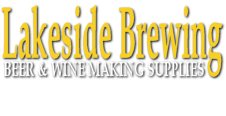Lakeside Brewery Tips
Our high quality products will work great for you!High quality beer & wine making supplies for you!
Beer & Wine Making Tips & FAQ
What is the difference in the Acids used in wine making?Citric Acid - is the most widely used acid. It is a natural product found in and derived from any citrus fruit. It is found in lemon, lime, grapefruit and oranges.
Malic Acid - this acid is naturally found in many fruits especially apples.
Tartaric Acid - an acid found predominantly in grapes, bananas and tamarinds It is added to other foods to give a sour taste, and is used as an antioxidant. Salts of tartaric acid are known as tartrates
Lactic Acid - " milk acid" occurs as an end result of Malo-lactic fermentation, which is a bacterial fermentation that occurs after the regular alccohol fermentation is complete.
Acetic Acid ( vinegar) - Vinegar bacteria often turns your wine into vinegar. This is often caused by less than sanitary conditions.
How can I keep my wine from oxidizing?
Oxidation occurs when there is a high level of vinegar bacteria. Make sure that all your equipment, utensils, and hands is sanitized with potassium metabisulphite. Oxidation will make your wine taste like vinegar and will not be suitable for drinking.
What should I do if my yeast does not start fermenting the fruit or if my fermentation is stuck?
By adding 1/2 tsp. of Energizer powder per gal. of wine will restart, a stuck fermentation, speed up a slow fermentation or simple give your yeast a faster start.
There are three scales on a hydrometer; what does each scale measure?
Specific Gravity
.99 to 1.170 measures how much sugar is in a liquid. Pure water @ 60 degrees will show 1.000. As sugar is added the specific gravity will increase.
Sugar increase the density of the water or other liquids.
Balling
Measures the percentage of sugar by weight; Balling or Brix also shows how much sugar is present as does the specific gravity. Most beer and wine making recipes refer to the specific gravity.
Potential Alcohol
This scale refers to the percentage of alcohol that will be produced if all the sugars present are converted. This reading needs to be taken before fermentation begins than again after the fermentation stops. The last reading is subtracted from the first reading ex: 12% - 1% = 11% of actual alcohol.
Conversion Information Measurements, Weight Equivalents, & More
| Tablet To Powder Conversion Chart | ||
| 1 Acid Blend Tablet | 3/4 level tsp. of powder | |
| 1 Nutrient Tablet | 1 level tsp. of powder | |
| 1 Tannin Tablet | 1/4 level tsp. of powder | |
| 1 Pectic Enzyme Tablet | 1/2 level tsp. of powder | |
| 1 Energizer Tablet | 1/4 level tsp. of powder | |
| 1 Anti-Oxidant Tablet | 1/2 level tsp. of powder | |
| 1 Stabilizer | 1/2 level tsp. of powder | |
| 1 Sparkolloid | 1 level tsp. of powder | |
| Weight Equivalents of Various Powders *approximate |
||
| Acid Blend Powder | 5 1/2 tsp. = 1 oz. | |
| Acid, Citric, Powder | 5 tsp. = 1 oz. | |
| Acid, Malic | 6 7/8 tsp. = 1 oz. | |
| White Granulated Sugar | 2 cups = 1 lb. | |
| Corn Sugar | 2 1/2 cups = 1 lb. | |
| Honey | 1 1/2 cups = 1 lb. | |
| Nutrient Powder | 4 tsp. = 1 oz. | |
| Pectic Enzyme Powder | 6 1/2 tsp. = 1 oz. | |
| Sorbistat K ( stabilizer) | 8 tsp. = 1 oz. | |
| Sulfite | 3 tbsp. = 1 oz. | |
| Tartaric Acid Powder | 5 1/2 tsp. = 1 oz. | |
| Suggested Starting Specific Gravities for: | ||
| Dry wine | 1.075 to 1.095 | |
| Sweet Wine | It is best to make a dry wine and sweeten it after the fermentation is complete | |
| Strong Dessert Wine | 1.120 starting gravity. To increase the alcohol add sugar in small amounts until fermentation stops and the desired sweetness is attained. | |



